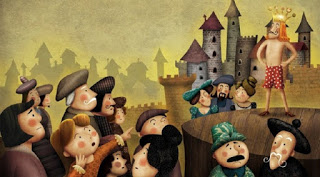[I’m out of the country for a few weeks so we’re posting classic posts from the past]
The Emperor’s new clothes
In my view, the models of Book of Mormon geography that put Cumorah anywhere except New York have essentially no utility.*
It’s easy to see why.
They are all based on two fundamental defects.
First, they reject what Joseph Smith and Oliver Cowdery said about Cumorah in Letter VII and elsewhere.
Second, they are based on a mistake in Church history that wrongly attributed to Joseph Smith statements written by others.
When your theory or model is based on such a sandy foundation, can you really be surprised when it eventually collapses?
_________
Recently a well-known tour leader claimed that when Joseph Smith was shown Catherwood’s drawings of Central America, he declared them to be ruins of Nephite cities. Of course, there is no such account. He was turning the anonymous Times and Seasons articles into a false narrative, fabricating a conversation that never took place.
 Fabrication is characteristic of the non-New York Cumorah theories. Proponents “see” volcanoes, jungles, Mayan ruins, tapirs, jaguars and more in the text of the Book of Mormon. Then they expect the rest of us to “see” these things as well, like the Emperor** who expected his subjects to “see” the fine clothing made out of nothing by the clever weavers.
Fabrication is characteristic of the non-New York Cumorah theories. Proponents “see” volcanoes, jungles, Mayan ruins, tapirs, jaguars and more in the text of the Book of Mormon. Then they expect the rest of us to “see” these things as well, like the Emperor** who expected his subjects to “see” the fine clothing made out of nothing by the clever weavers.
Like the fairy tale weavers, Mesoamerican proponents say the Mesoamerican elements in the text are invisible to those who are not sufficiently educated. You need expertise in a relevant field to understand the two-Cumorahs theory, for example.
But that’s not the only problem.
The more we learn about ancient Mesoamerican society, the less it can be construed to align with the Book of Mormon.
Experts are deciphering more and more records left by the ancient inhabitants of Central America, and the more they decipher, the more it becomes obvious that no one was quoting the Old Testament or explaining the ministry of Christ.
Nevertheless, there are characteristics of most human societies that are mentioned in the Book of Mormon and in ancient Mesoamerican accounts. The Mayans had kingdoms and wars and political intrigue. So did the Book of Mormon people. But what human society has not had kingdoms and wars and political intrigue?
If, instead of rejecting what Joseph and Oliver said, we embrace it, we soon see that the text of the Book of Mormon describes North America very well. That’s why I wrote Moroni’s America.
Not only that, the North American setting makes sense, now and in the future.
Unlike in Central America, the Native American Indians in North America did not leave behind extensive written records of their kings and battles.
Hmmm, you’re thinking. Maybe that’s why Nephi, Mosiah, Alma and the rest kept such careful records of these things on metal plates. They were not engraving stones and painting murals everywhere.
Maybe that’s why Enos and Mormon and Moroni were so concerned about the Lamanites destroying the plates; without the plates, the history would be lost.
Unlike in Mesoamerica.
Instead of creating new clothes out of whole cloth (i.e., fabricated or made up), how about if we stick with what the text actually says, and what the translators of the text said about it?
Let’s agree that there is one Cumorah and that it’s in New York. Then we can discuss the geography from there.
_______________
*I acknowledge that these models are important to people living in those areas because they seem to help people liken the scriptures to themselves. This utility is unrelated to explaining the real world or predicting the future.
**Reference to “The Emperor’s New Clothes,” described this way by wikipedia:
a short tale written by Danish author Hans Christian Andersen, about two weavers who promise an emperor a new suit of clothes that they say is invisible to those who are unfit for their positions, stupid, or incompetent. When the Emperor parades before his subjects in his new clothes, no one dares to say that they don’t see any suit of clothes on him for fear that they will be seen as “unfit for their positions, stupid, or incompetent”. Finally, a child cries out, “But he isn’t wearing anything at all!”
Source: Book of Mormon Wars
